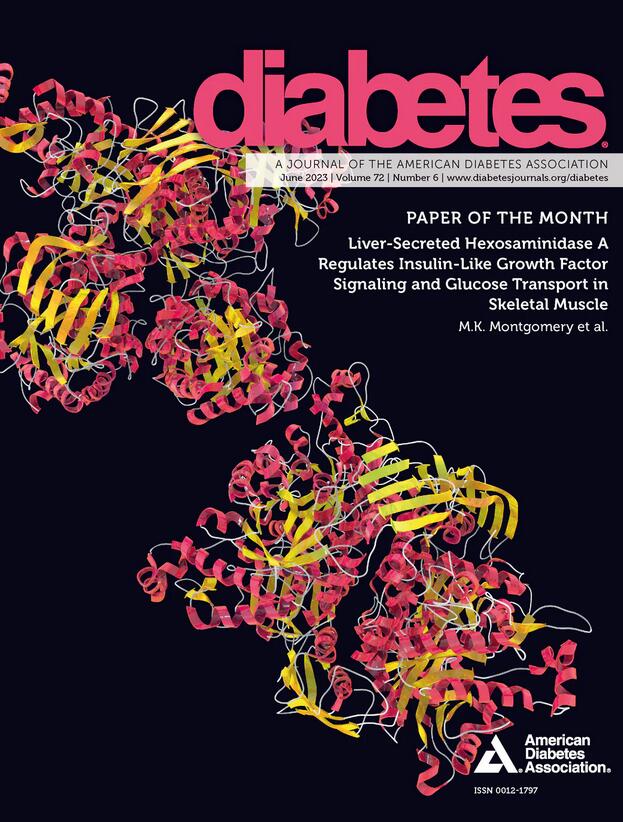229-OR: 奥锻利戎能改善 2 型糖尿病患者的 Beta 细胞功能和胰岛素敏感性指标
IF 6.2
1区 医学
Q1 ENDOCRINOLOGY & METABOLISM
引用次数: 0
摘要
Oforglipron(OFG)是一种口服、非肽类 GLP-1 受体激动剂,在一项对 2 型糖尿病(T2D)成人患者进行的为期 26 周的 2 期研究中,当剂量≥12 毫克与安慰剂(PBO)或度拉鲁肽(DU)1.5 毫克相比时,OFG 的血糖控制和体重减轻效果明显更好(表)。这些探索性分析通过分析探索性生物标志物,研究了 OFG 改善 T2D 血糖控制的机制。患有 T2D 的参与者(平均年龄 58.9 岁;基线 HbA1c 8.1%;体重 100.3 千克)在接受饮食和运动治疗并服用/不服用二甲双胍后,随机服用 PBO、DU 1.5 毫克或每日一次的 OFG 3、12、24、36 或 45 毫克。β细胞功能和胰岛素敏感性的生物标志物采用混合模型重复测量法进行分析,不包括研究药物停药或开始使用救援药物后的数据。与基线相比,服用 OFG 26 周后,β 细胞功能的生物标志物得到改善(表)。与 PBO 或 DU 相比,OFG 的剂量≥12 毫克时,HOMA-B 明显增加。OFG剂量≥24毫克时,HOMA-IR(用胰岛素计算)比基线明显降低,但与PBO和DU相比无明显差异。OFG剂量≥12毫克与PBO相比,空腹血糖调整后的胰高血糖素明显降低;OFG剂量12、24和45毫克与DU相比,空腹血糖调整后的胰高血糖素明显降低。这些分析表明,OFG 与 DU 相比,血糖控制的改善可能部分归因于 β 细胞功能和胰岛素敏感性的改善。目前正在进行更多研究,以了解这些机制。披露 J. 罗森斯托克:研究支持;Biomea Fusion, Inc.其他关系;礼来糖尿病公司。研究支持;默克公司、诺华制药公司、Corcept Therapeutics。其他关系;诺和诺德公司。研究支持;辉瑞公司。其他关系;赛诺菲、勃林格殷格翰。其他关系;赛诺菲公司、勃林格殷格翰公司。其他关系;Structure Therapeutics, Inc.顾问团;Terns Pharmaceuticals, Zealand Pharma A/S.其他关系;Applied Therapeutics、Hanmi Pharm.Co., Ltd.、Oramed Pharmaceuticals。顾问团;Scholar Rock。D.A. Robins:无。K.L. Duffin:礼来公司雇员。J.M. Wilson:礼来公司雇员。K. J. 马瑟礼来公司雇员H. Banerjee:无。Y. Lin:礼来公司、辉瑞公司、阿斯利康公司股票/股东。S. Eyde:无。C.M. Kazda:礼来公司员工。M. Konig:无。资助礼来公司本文章由计算机程序翻译,如有差异,请以英文原文为准。
229-OR: Orforglipron Improves Markers of Beta-Cell Function and Insulin Sensitivity in Type 2 Diabetes
Orforglipron (OFG), an oral, non-peptide GLP-1 receptor agonist, demonstrated significantly greater glycemic control and weight loss at doses ≥12 mg vs placebo (PBO) or dulaglutide (DU) 1.5 mg in a 26-week phase 2 study of adults with type 2 diabetes (T2D) (Table). These exploratory analyses investigated mechanisms by which OFG improved glycemic control in T2D by analyzing exploratory biomarkers. Participants with T2D (mean age, 58.9 years; baseline HbA1c, 8.1%; weight, 100.3 kg) treated with diet and exercise, with/without metformin, were randomized to PBO, DU 1.5 mg, or once-daily OFG 3, 12, 24, 36, or 45 mg. Biomarkers of β-cell function and insulin sensitivity were analyzed by mixed model repeated measures, excluding data after study drug discontinuation or rescue drug initiation. Biomarkers of β-cell function were improved by OFG at 26 weeks from baseline (Table). HOMA-B significantly increased with OFG at doses ≥12 mg vs PBO or DU. HOMA-IR (computed with insulin) significantly decreased from baseline with OFG at doses ≥24 mg but was not significantly different vs PBO and DU. Fasting glucose-adjusted glucagon significantly decreased with OFG at doses ≥12 mg vs PBO and with OFG 12, 24, and 45 mg vs DU. These analyses suggest improved glycemic control with OFG vs DU may be partly explained by improved β-cell function and insulin sensitivity. Additional studies are ongoing to understand these mechanisms. Disclosure J. Rosenstock: Research Support; Biomea Fusion, Inc. Other Relationship; Lilly Diabetes. Research Support; Merck & Co., Inc., Novartis Pharmaceuticals Corporation, Corcept Therapeutics. Other Relationship; Novo Nordisk. Research Support; Pfizer Inc. Other Relationship; Sanofi, Boehringer-Ingelheim. Research Support; Shionogi & Co., Ltd. Other Relationship; Structure Therapeutics, Inc. Advisory Panel; Terns Pharmaceuticals, Zealand Pharma A/S. Other Relationship; Applied Therapeutics, Hanmi Pharm. Co., Ltd., Oramed Pharmaceuticals. Advisory Panel; Scholar Rock. D.A. Robins: None. K.L. Duffin: Employee; Eli Lilly and Company. J.M. Wilson: Employee; Eli Lilly and Company. K.J. Mather: Employee; Eli Lilly and Company. H. Banerjee: None. Y. Lin: Stock/Shareholder; Eli Lilly and Company, Pfizer Inc., AstraZeneca. S. Eyde: None. C.M. Kazda: Employee; Eli Lilly and Company. M. Konig: None. Funding Eli Lilly and Company
求助全文
通过发布文献求助,成功后即可免费获取论文全文。
去求助
来源期刊

Diabetes
医学-内分泌学与代谢
CiteScore
12.50
自引率
2.60%
发文量
1968
审稿时长
1 months
期刊介绍:
Diabetes is a scientific journal that publishes original research exploring the physiological and pathophysiological aspects of diabetes mellitus. We encourage submissions of manuscripts pertaining to laboratory, animal, or human research, covering a wide range of topics. Our primary focus is on investigative reports investigating various aspects such as the development and progression of diabetes, along with its associated complications. We also welcome studies delving into normal and pathological pancreatic islet function and intermediary metabolism, as well as exploring the mechanisms of drug and hormone action from a pharmacological perspective. Additionally, we encourage submissions that delve into the biochemical and molecular aspects of both normal and abnormal biological processes.
However, it is important to note that we do not publish studies relating to diabetes education or the application of accepted therapeutic and diagnostic approaches to patients with diabetes mellitus. Our aim is to provide a platform for research that contributes to advancing our understanding of the underlying mechanisms and processes of diabetes.
 求助内容:
求助内容: 应助结果提醒方式:
应助结果提醒方式:


